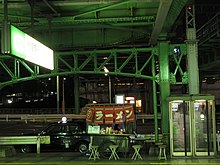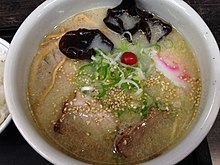Ramen
The ramen (ラーメン, ramen?) (pronounced roughly r`a:mEn, or ['ɽaːmɛɴ ]) is a Japanese noodle dish. Until 1950, in Japan, ramen was called shina soba (支那 そば, literally 'Chinese soba'). Nowadays, it is used chūka soba (中華 そば, which also means 'Chinese soba') or simply ramen, which is one of the most popular terms. Although each region of Japan has its own recipe for ramen, the basic preparation consists of different types of Japanese noodles served in a broth commonly prepared from pork or chicken bone and different vegetables, its flavors vary between miso paste, soy sauce (shoyu) or salt (shio), contains different garnishes such as sliced pork (チャーシュ chāshu), seaweed (海苔 nori), menma (メンマ) and spring onion (negi - 葱 cōng).
Etymology
The etymology of the word ramen is a matter of debate.[citation needed] One hypothesis is that probably ramen is the Japanese pronunciation of the Chinese 拉麵 (lāmiàn), which means 'stretch noodles'. A second hypothesis proposes 老麵 (lǎo miàn, 'old noodles') as the original form, while other sources state that it was initially 卤麺 (lǔmiàn), cooked noodles in a thick starchy sauce. A fourth hypothesis is 捞面 (lāo miàn): 捞 (lāo) means 'to dig up', and refers to the method of cooking the noodles, immersing them in boiling water before drag them up with a wire basket.
History
In the 1900s, restaurants serving Chinese food—in Guangzhou and Shanghai—offered a simple ramen noodle dish (cut rather than hand-separated), with few ingredients, and a broth flavored with salt and bone bones. pig.
Many Chinese ran street stalls and sold ramen and dumplings to workers. To announce their presence, they used a type of musical horn called a charumera (チャルメラ, from the Portuguese charamela), which some vendors still use.
However, it was after World War II when ramen began its journey in Japan. In 1950, the Sapporo ramen began to be made in the city of Hokkaidō. This dish became very popular and quickly the word ramen came into common use.
On August 25, 1958, Momofuku Andō, founder and president of Nissin Foods, launched chicken ramen, the first instant noodle soup, into the Japanese market.
But it is in the 1980s when this dish went from being considered a mere garnish to becoming a normal meal for both young and old people. Finally, in the early 1990s, ramen experiences a boom throughout the country, especially in the huge cities, which would put their name as a local brand: Hakata (Fukuoka), Kagoshima, Kumamoto, Onomichi, Wakayama., Kitakata, Sapporo, Hakodate, etc. Ramen was considered more than just a passing gastronomic whim and became a true social and even media phenomenon: some media outlets even created programs dedicated exclusively to this dish.
Today, ramen has become so strongly integrated into Japanese gastronomy that in Taiwan it is considered a purely Japanese product and a staple in that country's diet. It is usually consumed in fast food establishments, in street stalls or at home, being one of the cheapest foods that can be obtained.
Ingredients
The most important ingredients of ramen are the men (麺) or noodles, the soup, and the gu or accompaniment that is added to the dish.
Noodles
The noodle is made with wheat flour, water, salt and kansui. Egg is sometimes used instead of kansui to give the pasta its distinctive yellow color. Also, semolina is used, instead of cornmeal, to make them.
Soup
While many consider the most important thing about ramen to be the type of noodle, the easiest way to differentiate the variants is by the soup in which the noodle is served. The most features are:
- Shōyu ()., literally: ‘ soy sauce’). Considered the most Japanese. It consists of chicken, which is added a couple of spoonfuls of thick soy sauce when served. Traditionally added later rayu (interpretation, red pepper extract with sesame oil) to taste.
- Tonkotsu ()., literally: ‘pig bones’). Soup is mainly based on pork, has plenty of body and fatty content. The broth is usually white. Born in northern Kyūshū.
- Miso (味). Created in Sapporo in 1955. It is usually prepared based on chicken, and mixed with some variety of mass when served. In Kantō, it is common to add a spoonful of butter.
- Shio ()., literally: ‘salt’). The simplest of all varieties, and in which it feels the greatest Chinese influence. It is considered very popular in Hokkaidō. The soup is transparent and its taste is more direct.
From these there is a greater variety, although usually the only difference is what is used as gu.
Gu (具)
The accompanying ingredients are very varied and most of the time it is left to the choice of the consumer. The most common options are boiled eggs, menma or shinachiku (支那竹 zhīnà zhú, pickled very young bamboo trunk), nori, wakame, pork slices, chāshū (叉焼 or 焼豚 yakibuta), negi (scallions), naruto, kimchi and boiled vegetables.
Museum
There is a museum dedicated exclusively to ramen. This is the Shin-Yokohama Ramen Museum, located in the city of Yokohama, which exhibits the various utensils that have been used throughout history to make these noodles. The museum also has samples of all the varieties of ramen that exist, as well as a park that recreates a typical city of the 1950s where you can visit recreations of the different types of ramen restaurants that were created at that time.
Contenido relacionado
Sri Lankan flag
Chilean culture
Islamic art







